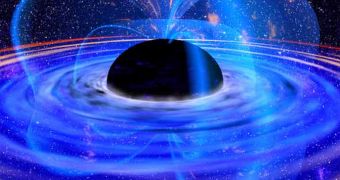A study of a very distant quasar has finally enabled astronomers to peer back into what experts refer to as the “Dark Ages” of the Universe, a time shortly after the Big Bang when light was scarce.
The fact that light was not being produced in large amounts means that there are no residual radiation for our telescopes to pick up and analyze. As such, for decades, astronomers have been in the dark about what went on between 13.75 billion years ago and the time when the first stars appeared.
According to the latest investigations, this happened around 200 million years later. During this time, there was literally no light source in the Universe, as everything was still a uniform mass of hot gas.
But scientists can peer back in time by analyzing light emitted by quasars, the highly luminous cores of distant, active galaxies. These structures always contain supermassive black holes at their centers.
Experts with the Cambridge University were able to use that data inscribed in a quasar's light to gain more information about the Universal Dark Ages. They were also able to analyze the light emitted by the violent explosion which accompanied the death of an extremely old massive star.
The object was nearly 25 times more massive than out Sun, says Cambridge Institute of Astronomy professor Max Pettini. The gas trails that the supernova explosion left behind can be used to scout deep into the history of the Cosmos.
“We have effectively been able to peer into the Dark Ages using the light emitted from a quasar. The light provides a backdrop against which any gas cloud in its path can be measured,” the expert says.
“We discovered tiny amounts of elements present in the cloud in proportions that are very different from their relative proportions in normal stars today,” Pettini explains further.
“Most significantly, the ratio of carbon to iron is 35 times greater than measured in the Sun. The composition enables us to infer that the gas was released by a star 25 times more massive than the Sun and originally consisting of only hydrogen and helium,” he adds.
“In effect, this is a fossil record that provides us with a missing link back to the early Universe,” adds the Cambridge investigator, quoted by Daily Galaxy.
In a collaborative effort with colleagues from the California Institute of Technology (Caltech), the Cambridge scientists managed to use the light emitted by the distant quasar to evidence the properties of the gases the supernova blast left behind.
The gas clouds were located between Earth and the quasar, and so they were basically lit up from behind, providing the team with an excellent medium for conducting research.

 14 DAY TRIAL //
14 DAY TRIAL //